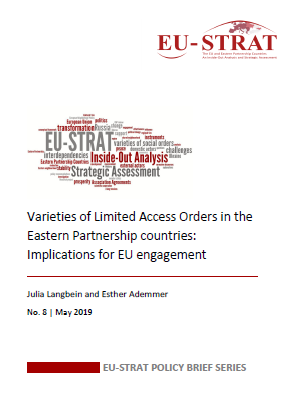Authors: Julia Langbein and Esther Ademmer
May 2019

Resume:
Ten years ago, the Eastern Partnership (EaP) was launched as the Eastern dimension of the European Neighbourhood Policy. It aims at promoting political and economic reforms that would bring the six EaP countries, namely Armenia, Azerbaijan, Belarus, Georgia, Moldova and Ukraine, closer to EU norms and standards. As of today, developments in the EaP countries reveal mixed trends: some countries, such as Armenia and Ukraine, have indeed witnessed instances of political and economic reform resulting in increased competition in both spheres and which could eventually pave the way towards democracy and prosperity. Notwithstanding, all six countries continue to operate as hybrid regimes combining elements of democracy and autocracy, albeit to different degrees. Moreover, in all EaP countries, sustainable and inclusive economic growth is hampered by clientelistic rent-seeking elites who restrict economic competition and the emergence of market-enhancing institutions.
Our research project EU-STRAT set out to examine what room for action there is for the EU to promote political and economic opening in the six EaP countries and what strategies could be (in)effective to achieve this goal. In so doing, we placed the analysis of domestic conditions at the centre of our analysis. EU-STRAT is premised on the idea that deep knowledge of the dynamics of social orders, with specific attention to differences in how dominant elites restrict access to political and economic resources, is fundamental to make an informed assessment of whether and how the EU can help to bring about political and economic opening in the various EaP countries.
To this end, EU-STRAT broadly understands the six EaP countries as Limited Access Orders (LAOs) where the ruling elite restricts access to economic and political resources for private gains. This is in contrast to Open Access Orders (OAOs) based on economic and political competition. EU-STRAT’s research shows that the six EaP countries vary in how incumbents undermine a level playing field by restricting or opening access to political and economic resources. Some allow for relatively balanced forms of access to political and economic resources, while in others, this access is unbalanced, allowing either for more access to political resources than to economic resources or posing fewer limits on accessing economic resources than on political ones. This research has also shown that the various types of LAOs are associated with distinct operating logics underlying hybrid (in)stability that helped us form expectations about what kind of change is relevant for moving them towards more openness or closure. In this policy brief, we recap these insights and combine them with further insights from research under EU-STRAT in order to derive specific policy recommendations for the EU’s current engagement with various EaP countries.
